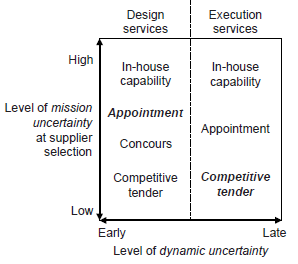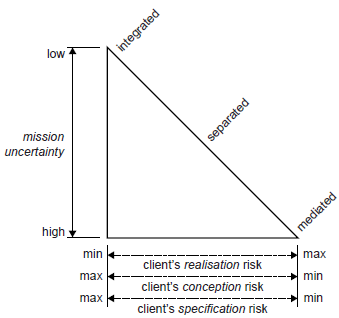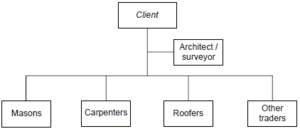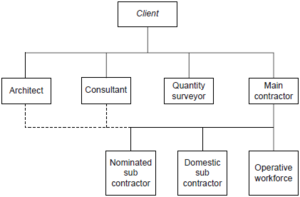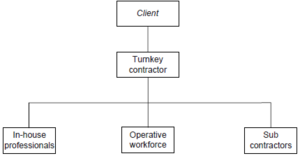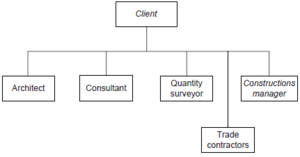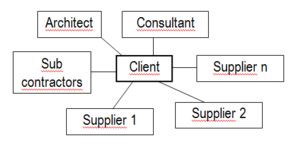Forming the Project Coalition
| Line 44: | Line 44: | ||
[[File:s170060formingprojectcoalition.PNG|800px|thumb|Figure 2: Formation of project coalition.[1]]] | [[File:s170060formingprojectcoalition.PNG|800px|thumb|Figure 2: Formation of project coalition.[1]]] | ||
| − | Project coalition creates structures for organizations and individuals to share resources and common goals. Coalition tasks and responsibilities should be clearly defined and assignments equitably distributed on the basis of the members areas of expertise. At the heart of every successful coalition, there should be a small group of leaders who are deeply committed to both the issue, and to ensuring that the overall goals of the coalition take precedence over the narrow interest of individual member organizations. In the building industry where big number of suppliers is present, project coalition creates hierarchy of project participants, | + | Project coalition creates structures for organizations and individuals to share resources and common goals. Coalition tasks and responsibilities should be clearly defined and assignments equitably distributed on the basis of the members areas of expertise. At the heart of every successful coalition, there should be a small group of leaders who are deeply committed to both the issue, and to ensuring that the overall goals of the coalition take precedence over the narrow interest of individual member organizations. In the building industry where big number of suppliers is present, project coalition creates hierarchy of project participants, and defines futuer project managment plan. |
We can distinguish three main type of project coalitions: ''integrated'', ''separated'', and ''mediated''. And fourth called ''unmediated'' coalition where client is in direct contact with all suppliers. Client selects most appropriate one depend on the project risk and uncertainty. For the simple project where the uncertainty is small the integrated coalition is most comment. With the increase of project complexity the separated or mediate coalitions are more favourable. Dependence of the coalition type in respect to uncertainty and risk is show on the graph in figure 2. | We can distinguish three main type of project coalitions: ''integrated'', ''separated'', and ''mediated''. And fourth called ''unmediated'' coalition where client is in direct contact with all suppliers. Client selects most appropriate one depend on the project risk and uncertainty. For the simple project where the uncertainty is small the integrated coalition is most comment. With the increase of project complexity the separated or mediate coalitions are more favourable. Dependence of the coalition type in respect to uncertainty and risk is show on the graph in figure 2. | ||
Revision as of 17:21, 12 June 2017
Contents |
Project Coalition
A coalition is defined as interaction of two o more members who adopt common strategy toward a common goal. The client’s task is to find the firms which will provide resources required and adopt most convenient cooperation-model to fulfil project mission. The process of procurement is used in the construction industry for selection and review of different suppliers and services. And the resource base is analysed based on the criteria such as price, value and reputation.
Client and suppliers
The client deals with the problem called asymmetry of information once, and what occurs most often, the suppliers knows more about its real competence in supplying required resources. The client needs a tools to investigate the supplier quality, reliability and price for required resources. In the field of construction the asymmetry generates two problems defines as: Moral hazard and Adverse selection. Both are related to reliability of a supplier.
• Moral hazard – How can the client be sure that the firm will fully mobilise its capabilities on the client’s behalf.
• Adverse selection – How the client be sure that the most enthusiastic offer of the requested resources is not also the most desperate.
Selection of appropriate procurement
Selection of the supplier depends on the level of the uncertainty and the resources required in the time of making decision. According to the Graham M. Winch selection method can be illustrated as function of level of dynamic uncertainty and level of mission uncertainty, see figure 1. From the graph we can establish the most appropriate method of the procuring services for our project and stage in which it is. For example the client is planning to build simple multifamily building with repetitive structure and it is at the early stage of the schedule. The level of mission uncertainty is low and dynamic uncertainty is at the early stage so most appropriate is use of the competitive tendering. The decision making is based on the two interacting dimensions defined as:
• The level of mission uncertainty – the uncertainty is increasing for the big and unique projects
• The phase in the project life cycle – defines the level of the dynamic uncertainty. It increases with the time propagation in the project schedule.
Processes of procuring construction services
Procurement is the process of finding, agreeing terms and acquring goods, services or works from external source. The process is used to ensure the buyer recives goods, services or works at the best possible price, when aspects such as quality, quantity, time and location are compared.[2] Client define processes intended to promote fair and open competition for his business. Each procuring process is more convenient for different kids of the project stages: design, construction erection, resources/materials supply, quality surveys, estate maintenance. Selection is also related to the size of the project, uncertainties, phase in the project life cycle. These procure processes are:
• In-house capability
A client is conducting an activity or operation within a company, instead of relying on outsourcing. A firm uses its own resources to perform the necessary tasks. The main advantages of this form is direct contact of client with supplier what provides adjustable relation and no need of complete contract, also full control on audit and evaluation of works done by supplier. However due to lack of competition production efficiency decreases what rises production costs. There is also risk of low quality in the project management when construction is not the main business of the client.
• Appointment
Supplier is nominated based on the reputation for having previously completed projects. This method is most common for the design and project management services. Also is used on construction site services while schedule is delayed. This mehtod is very qucik and safe while client is nomineting trusted supplier from his own database but becouse of no competition and close relations of contract members there is high risk of low effectivness and communication problems.
• Concours
Method is dedicated for design services and mostly is used for the public investments or for unique needs of private client. The Concours can be open or close with invitation for particular designers. The aim of the concur is to select the individual, high standard project. Concours gives opportunity for all designer even for no experienced with low budged beginners. Most often it draws lot of attention and high number of candidates what increases competition and gives high quality, unique designs. Also client can easily develop his network of suppliers. On the other hand organizing a concours is costly and time consuming. Moreover client have to be aware that project will be very challenging in the construction process and could generate high costs.
• Competitive tendering
Sellers are presenting their valuations of the contract based on the detailed description provided by client. In general, the tender with the lowest price wins the order, although factors related to quality, shipping, timeliness, and efficiency, may also be a consideration. The method promote high competition, provide transparency and gives all suppliers the opportunity to win a contract. High competition between tenders drives down the price. Selection of the supplier based on the lowest price can generate unexpected problem in the construction process. Supplier can be unable to finish his work because too low capabilities - lack of experience and resources.
The formation of project coalitions
Project coalition creates structures for organizations and individuals to share resources and common goals. Coalition tasks and responsibilities should be clearly defined and assignments equitably distributed on the basis of the members areas of expertise. At the heart of every successful coalition, there should be a small group of leaders who are deeply committed to both the issue, and to ensuring that the overall goals of the coalition take precedence over the narrow interest of individual member organizations. In the building industry where big number of suppliers is present, project coalition creates hierarchy of project participants, and defines futuer project managment plan.
We can distinguish three main type of project coalitions: integrated, separated, and mediated. And fourth called unmediated coalition where client is in direct contact with all suppliers. Client selects most appropriate one depend on the project risk and uncertainty. For the simple project where the uncertainty is small the integrated coalition is most comment. With the increase of project complexity the separated or mediate coalitions are more favourable. Dependence of the coalition type in respect to uncertainty and risk is show on the graph in figure 2.
• Separated project coalition
Two kind of separated coalition are developed: traditional – trade contracting, and general contracting. In the first one the architect, in union with the client, is responsible for choosing and contracting suppliers of the construction services. Hierarchy is shown in the figure 3.1 The second type introduces the position of Main contractor which is responsible for contracting all construction services. Architect, Consultant unit, Quality surveyor, and Main contractor are on the equal level in relation to the client. All this units has to cooperate together and provide effective service while Architect and Consultant can have infulance on the decisions of Main contractor. Coalition scheme is shown in the figure 3.2. In both models services are procured by competitive tendering or appointment.
• Integrated project coalition
This coalition is characterized by one unit responsible for all services: design, resources, contracting etc. The unit is called Turnkey contractor. In this way the coordinating unit takes all risk from the project contracting. Client need to appoint the service it very early stage of the project. Coalition is illustrated in figure 4.
• Mediate project coalition
It mediate coalition a role of Construction manager is introduced. From the assumption that this coalition is dedicated for projects of high uncertainty the position of construction manager is crucial for final success of mission. Function of manager is to procure and managing all trade contractors which are involved in the construction site works. He is also responsible for the technologies which are going to be used and the procurement of suppliers and final bugged of construction site.
• Unmediate project coalition
In this case client is in direct contact with all suppliers and coordinate them by itself. Therefore client carry the responsibility for contracting suppliers and risk related to this. Moreover unmediated coalition requires high in-house capability in the field of project management. Direct contact is favoured by the clients who prefers to be in close relations with the suppliers and have short and effective communication with them.
Summary
References
- Winch, Graham (2010) Managing Construction Projects. An Information Processing Approach. Second Edition, Wiley-Blackwell, United Kingdom.
- Weele, Arjan J. van (2010). Purchasing and Supply Chain Management: Analysis, Strategy, Planning and Practice (5th ed.). Andover: Cengage Learning.
